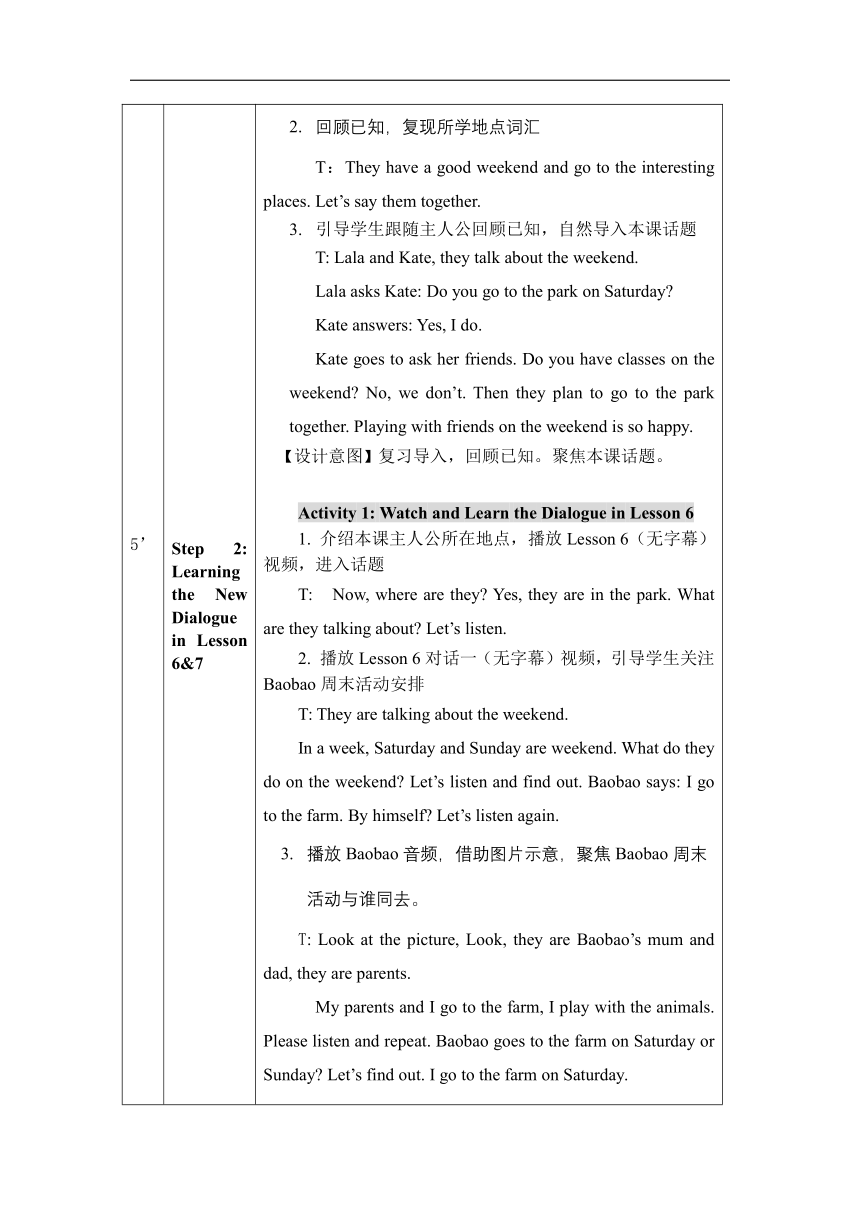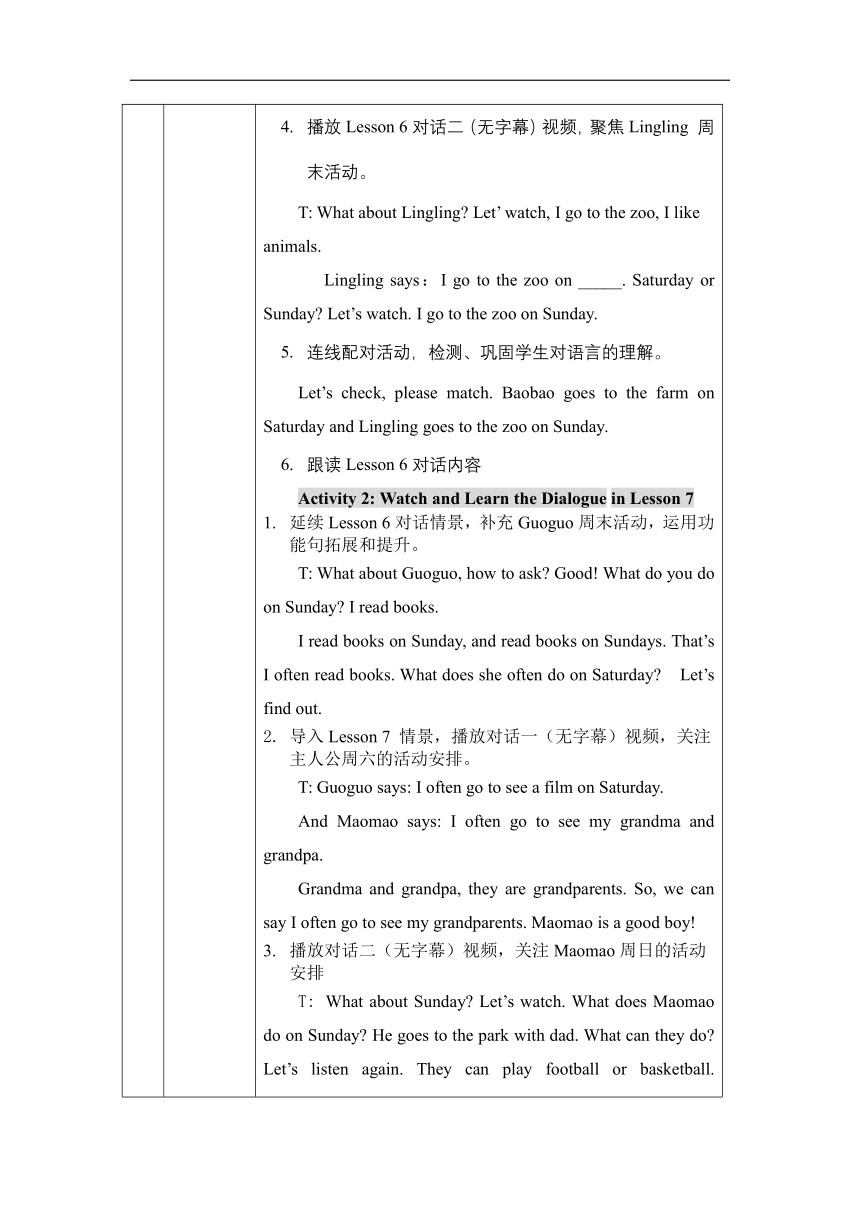Unit2 what do you do on Sunday lesson8 表格式教案
文档属性
| 名称 | Unit2 what do you do on Sunday lesson8 表格式教案 |

|
|
| 格式 | docx | ||
| 文件大小 | 354.1KB | ||
| 资源类型 | 教案 | ||
| 版本资源 | 北京版 | ||
| 科目 | 英语 | ||
| 更新时间 | 2021-08-05 20:45:42 | ||
图片预览



文档简介
课题
Unit2 what do you do on Sunday(2)
教学目标
教学目标:
1. 理解并朗读Lesson 6-7课文,在语境中学习句型What do you do on Saturday/ Sunday?询问周末的活动并回答。
2. 在语境中理解、认读并运用短语:draw pictures, read books, go to the zoo, go to buy books, go to see a film, go to see my grandparents并复现第一单元 go swimming, go dancing, go boating等活动短语,体会周末活动的丰富多彩。
3. 借助绘本学习字母组合ea ee在单词中的读音。
4. 鼓励学生周末尝试新事物,有更丰富的体验。
教学重点:
1. 在语境中学习句型What do you do on Saturday/Sunday?询问周末的活动并回答。
2. 在语境中理解、认读并运用短语:draw pictures, read books, go to the zoo, go to buy books, go to see a film, go to see my grandparents并复现第一单元 go swimming, go dancing, go boating等活动短语, 体会周末活动的丰富多彩。
教学难点:
在语境中学习句型What do you do on Sunday/Saturday?询问周末的活动并回答。
教学过程
时间
教学环节
主要师生活动
2’
5’
5’
5’
2’
Step 1: Leading in the topic
Step 2: Learning the New Dialogue in Lesson 6&7
Step 3 Practicing to Use the Dialogue
Step 4: Phonics Time
Step 5: Summary
Activity 1: Greetings
T: Hello, boys and girls. Nice to see you again.
I’m your English teacher Ms. Li. This lesson, please follow me, think, and answer the questions, listen carefully and repeat, OK? Good! Let’s begin our class.
Activity 2: Review and lead in
通过歌谣热身并复习第五课学习的地点词汇,铺垫本课新短语。
Let’s chant.
Many places to go, let’s go to the park. I draw pictures.
draw pictures.
Many places to go, let’s go to the cinema. I see a film.
see a film
Many places to go, let’s go to the bookstore. I buy books.
buy books
Let’s take them home, and read books.
Many places to go, let’s have fun!
回顾已知,复现所学地点词汇
T:They have a good weekend and go to the interesting places. Let’s say them together.
引导学生跟随主人公回顾已知,自然导入本课话题
T: Lala and Kate, they talk about the weekend.
Lala asks Kate: Do you go to the park on Saturday?
Kate answers: Yes, I do.
Kate goes to ask her friends. Do you have classes on the weekend? No, we don’t. Then they plan to go to the park together. Playing with friends on the weekend is so happy.
【设计意图】复习导入,回顾已知。聚焦本课话题。
Activity 1: Watch and Learn the Dialogue in Lesson 6
1. 介绍本课主人公所在地点,播放Lesson 6(无字幕)视频,进入话题
T: Now, where are they? Yes, they are in the park. What are they talking about? Let’s listen.
2. 播放Lesson 6对话一(无字幕)视频,引导学生关注Baobao周末活动安排
T: They are talking about the weekend.
In a week, Saturday and Sunday are weekend. What do they do on the weekend? Let’s listen and find out. Baobao says: I go to the farm. By himself? Let’s listen again.
播放Baobao音频,借助图片示意,聚焦Baobao周末活动与谁同去。
T: Look at the picture, Look, they are Baobao’s mum and dad, they are parents.
My parents and I go to the farm, I play with the animals. Please listen and repeat. Baobao goes to the farm on Saturday or Sunday? Let’s find out. I go to the farm on Saturday.
播放Lesson 6对话二(无字幕)视频,聚焦Lingling 周末活动。
T: What about Lingling? Let’ watch, I go to the zoo, I like animals.
Lingling says:I go to the zoo on _____. Saturday or Sunday? Let’s watch. I go to the zoo on Sunday.
连线配对活动,检测、巩固学生对语言的理解。
Let’s check, please match. Baobao goes to the farm on Saturday and Lingling goes to the zoo on Sunday.
跟读Lesson 6对话内容
Activity 2: Watch and Learn the Dialogue in Lesson 7
延续Lesson 6对话情景,补充Guoguo周末活动,运用功能句拓展和提升。
T: What about Guoguo, how to ask? Good! What do you do on Sunday? I read books.
I read books on Sunday, and read books on Sundays. That’s I often read books. What does she often do on Saturday? Let’s find out.
导入Lesson 7 情景,播放对话一(无字幕)视频,关注主人公周六的活动安排。
T: Guoguo says: I often go to see a film on Saturday.
And Maomao says: I often go to see my grandma and grandpa.
Grandma and grandpa, they are grandparents. So, we can say I often go to see my grandparents. Maomao is a good boy!
播放对话二(无字幕)视频,关注Maomao周日的活动安排
T: What about Sunday? Let’s watch. What does Maomao do on Sunday? He goes to the park with dad. What can they do? Let’s listen again. They can play football or basketball. 4. 在图片示意和音频跟读下,理解、跟读Lesson 7对话
Activity 3: Practice the Dialogue in Lesson 6 and Lesson 7
2328545135255连线活动,检查学生对两课课文内容的理解,并灵活运用本课语言进行复述。(见图1)
小黑板小结本课对话内容及功能句型,体会周末活动的丰富多彩。 图1
226822081915猜谜游戏,通过图片剪影效果进行猜测,巩固所学短语并复习第一单元出现的活动短语等。(见图2)
【设计意图】通过图片示意、逐 句跟读、连线等方式,帮助学生 图2
理解、记忆功能句型;在跟读过程中,引导学生练习句型,读准发音;通过小黑板小结本课功能句型,帮助学生做阶段性小结。
Activity 1: Use the language
呈现小兔子们聊天的情景,引导学生在情景中操练和运用学过的句型。
情景呈现
T: Look, Bunny and Buffy are coming. Buffy really wants to eat the carrots. But how?
运用所学语言,迁移创新。
(见图3)
294005109855
图3
Buffy: What do you do on Monday?
Bunny: I draw pictures.
Buffy: What do you do on Tuesday?
Bunny: I go to the farm.
Buffy: What do you do on Wednesday?
Bunny: I go to the park.
Buffy: What do you do on Thursday?
Bunny: I draw pictures. What about you? What do you do on Sunday?
Buffy: I eat carrots. Ha-ha.
Bunny: Oh, no. My carrots.
【设计意图】在新的场景中拓展本课对话,指导学生在不同的场景中运用本课功能句型。通过新情景,考查学生是否掌握本课功能句型,运用语言询问和回答一周的活动。
Activity 1: Tell a Story
师生图片环游绘本,理解故事。
An eagle plays magic every week. The queen comes to see. He puts a leaf on her knee. Wow, a peach for the queen.
通过节奏明快的歌谣,关注故事语言
借助故事情境关注语音词汇。
Activity 2: Learn the Sound / i:/
教师通过问题引领,回顾呈现故事中含有字母组合ee,ea的单词,引导学生复习字母组合在单词中的读音/i:/。并将这些单词进行分类。
Activity 3: Practice the Sound / i:/ and learn to read new words
课件中出示图文并茂的含有ee ea发音/ i:/单词,并逐一指导学生拼读这些单词,巩固字母组合ee,ea在单词中发/ i: /的音。
【设计意图】采用学生喜欢的讲故事的方式,复习字母组合的发音。
Activity 1: Summarize the Language and the Sound of “ea, ee”
课件呈现小黑板,小黑板逐一呈现本课主要功能句型和语音单词。
Activity 2: Homework
Listen and read Lesson 6, Lesson 7.
Finish the task.
T: So much for today. See you next time.
【设计意图】总结梳理对话、语音部分,布置作业。
Unit2 what do you do on Sunday(2)
教学目标
教学目标:
1. 理解并朗读Lesson 6-7课文,在语境中学习句型What do you do on Saturday/ Sunday?询问周末的活动并回答。
2. 在语境中理解、认读并运用短语:draw pictures, read books, go to the zoo, go to buy books, go to see a film, go to see my grandparents并复现第一单元 go swimming, go dancing, go boating等活动短语,体会周末活动的丰富多彩。
3. 借助绘本学习字母组合ea ee在单词中的读音。
4. 鼓励学生周末尝试新事物,有更丰富的体验。
教学重点:
1. 在语境中学习句型What do you do on Saturday/Sunday?询问周末的活动并回答。
2. 在语境中理解、认读并运用短语:draw pictures, read books, go to the zoo, go to buy books, go to see a film, go to see my grandparents并复现第一单元 go swimming, go dancing, go boating等活动短语, 体会周末活动的丰富多彩。
教学难点:
在语境中学习句型What do you do on Sunday/Saturday?询问周末的活动并回答。
教学过程
时间
教学环节
主要师生活动
2’
5’
5’
5’
2’
Step 1: Leading in the topic
Step 2: Learning the New Dialogue in Lesson 6&7
Step 3 Practicing to Use the Dialogue
Step 4: Phonics Time
Step 5: Summary
Activity 1: Greetings
T: Hello, boys and girls. Nice to see you again.
I’m your English teacher Ms. Li. This lesson, please follow me, think, and answer the questions, listen carefully and repeat, OK? Good! Let’s begin our class.
Activity 2: Review and lead in
通过歌谣热身并复习第五课学习的地点词汇,铺垫本课新短语。
Let’s chant.
Many places to go, let’s go to the park. I draw pictures.
draw pictures.
Many places to go, let’s go to the cinema. I see a film.
see a film
Many places to go, let’s go to the bookstore. I buy books.
buy books
Let’s take them home, and read books.
Many places to go, let’s have fun!
回顾已知,复现所学地点词汇
T:They have a good weekend and go to the interesting places. Let’s say them together.
引导学生跟随主人公回顾已知,自然导入本课话题
T: Lala and Kate, they talk about the weekend.
Lala asks Kate: Do you go to the park on Saturday?
Kate answers: Yes, I do.
Kate goes to ask her friends. Do you have classes on the weekend? No, we don’t. Then they plan to go to the park together. Playing with friends on the weekend is so happy.
【设计意图】复习导入,回顾已知。聚焦本课话题。
Activity 1: Watch and Learn the Dialogue in Lesson 6
1. 介绍本课主人公所在地点,播放Lesson 6(无字幕)视频,进入话题
T: Now, where are they? Yes, they are in the park. What are they talking about? Let’s listen.
2. 播放Lesson 6对话一(无字幕)视频,引导学生关注Baobao周末活动安排
T: They are talking about the weekend.
In a week, Saturday and Sunday are weekend. What do they do on the weekend? Let’s listen and find out. Baobao says: I go to the farm. By himself? Let’s listen again.
播放Baobao音频,借助图片示意,聚焦Baobao周末活动与谁同去。
T: Look at the picture, Look, they are Baobao’s mum and dad, they are parents.
My parents and I go to the farm, I play with the animals. Please listen and repeat. Baobao goes to the farm on Saturday or Sunday? Let’s find out. I go to the farm on Saturday.
播放Lesson 6对话二(无字幕)视频,聚焦Lingling 周末活动。
T: What about Lingling? Let’ watch, I go to the zoo, I like animals.
Lingling says:I go to the zoo on _____. Saturday or Sunday? Let’s watch. I go to the zoo on Sunday.
连线配对活动,检测、巩固学生对语言的理解。
Let’s check, please match. Baobao goes to the farm on Saturday and Lingling goes to the zoo on Sunday.
跟读Lesson 6对话内容
Activity 2: Watch and Learn the Dialogue in Lesson 7
延续Lesson 6对话情景,补充Guoguo周末活动,运用功能句拓展和提升。
T: What about Guoguo, how to ask? Good! What do you do on Sunday? I read books.
I read books on Sunday, and read books on Sundays. That’s I often read books. What does she often do on Saturday? Let’s find out.
导入Lesson 7 情景,播放对话一(无字幕)视频,关注主人公周六的活动安排。
T: Guoguo says: I often go to see a film on Saturday.
And Maomao says: I often go to see my grandma and grandpa.
Grandma and grandpa, they are grandparents. So, we can say I often go to see my grandparents. Maomao is a good boy!
播放对话二(无字幕)视频,关注Maomao周日的活动安排
T: What about Sunday? Let’s watch. What does Maomao do on Sunday? He goes to the park with dad. What can they do? Let’s listen again. They can play football or basketball. 4. 在图片示意和音频跟读下,理解、跟读Lesson 7对话
Activity 3: Practice the Dialogue in Lesson 6 and Lesson 7
2328545135255连线活动,检查学生对两课课文内容的理解,并灵活运用本课语言进行复述。(见图1)
小黑板小结本课对话内容及功能句型,体会周末活动的丰富多彩。 图1
226822081915猜谜游戏,通过图片剪影效果进行猜测,巩固所学短语并复习第一单元出现的活动短语等。(见图2)
【设计意图】通过图片示意、逐 句跟读、连线等方式,帮助学生 图2
理解、记忆功能句型;在跟读过程中,引导学生练习句型,读准发音;通过小黑板小结本课功能句型,帮助学生做阶段性小结。
Activity 1: Use the language
呈现小兔子们聊天的情景,引导学生在情景中操练和运用学过的句型。
情景呈现
T: Look, Bunny and Buffy are coming. Buffy really wants to eat the carrots. But how?
运用所学语言,迁移创新。
(见图3)
294005109855
图3
Buffy: What do you do on Monday?
Bunny: I draw pictures.
Buffy: What do you do on Tuesday?
Bunny: I go to the farm.
Buffy: What do you do on Wednesday?
Bunny: I go to the park.
Buffy: What do you do on Thursday?
Bunny: I draw pictures. What about you? What do you do on Sunday?
Buffy: I eat carrots. Ha-ha.
Bunny: Oh, no. My carrots.
【设计意图】在新的场景中拓展本课对话,指导学生在不同的场景中运用本课功能句型。通过新情景,考查学生是否掌握本课功能句型,运用语言询问和回答一周的活动。
Activity 1: Tell a Story
师生图片环游绘本,理解故事。
An eagle plays magic every week. The queen comes to see. He puts a leaf on her knee. Wow, a peach for the queen.
通过节奏明快的歌谣,关注故事语言
借助故事情境关注语音词汇。
Activity 2: Learn the Sound / i:/
教师通过问题引领,回顾呈现故事中含有字母组合ee,ea的单词,引导学生复习字母组合在单词中的读音/i:/。并将这些单词进行分类。
Activity 3: Practice the Sound / i:/ and learn to read new words
课件中出示图文并茂的含有ee ea发音/ i:/单词,并逐一指导学生拼读这些单词,巩固字母组合ee,ea在单词中发/ i: /的音。
【设计意图】采用学生喜欢的讲故事的方式,复习字母组合的发音。
Activity 1: Summarize the Language and the Sound of “ea, ee”
课件呈现小黑板,小黑板逐一呈现本课主要功能句型和语音单词。
Activity 2: Homework
Listen and read Lesson 6, Lesson 7.
Finish the task.
T: So much for today. See you next time.
【设计意图】总结梳理对话、语音部分,布置作业。
同课章节目录
- Unit 1 What day is today?
- Lesson 1
- Lesson 2
- Lesson 3
- Lesson 4
- Unit 2 What do you do on Sunday?
- Lesson 5
- Lesson 6
- Lesson 7
- Lesson 8
- Unit 3 What's your number?
- Lesson 9
- Lesson 10
- Lesson 11
- Lesson 12
- Unit 4 There are many animals
- Lesson 13
- Lesson 14
- Lesson 15
- Lesson 16
- Unit 5 I have long arms
- Lesson 17
- Lesson 18
- Lesson 19
- Lesson 20
- Unit 6 It‘s Christmas Day
- Lesson 21
- Lesson 22
- Lesson 23
- Lesson 24
